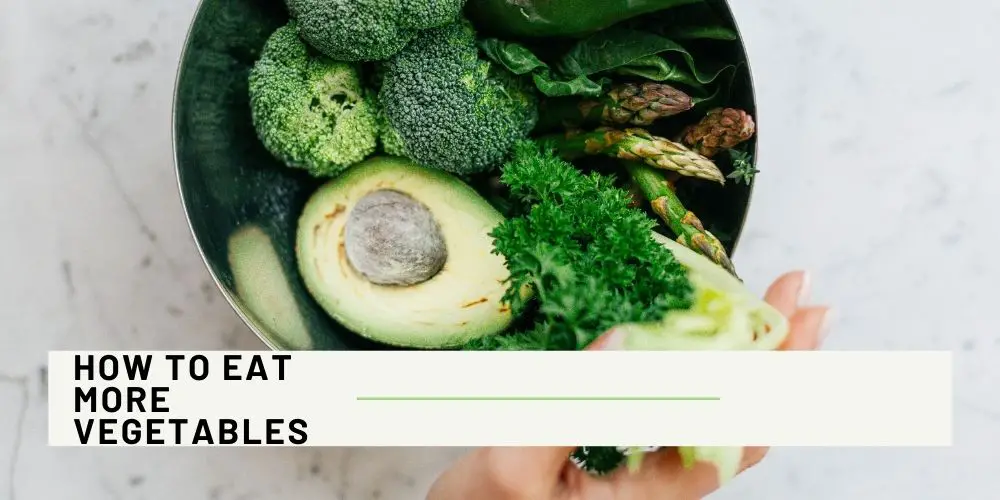How To Eat More Vegetables
It sounds so easy, just eat more vegetables to be healthy. But in reality, it isn’t so simple. Some of us don’t love the taste and barely have time to get dinner on the table. We just want a meal that everyone will love, and if that includes vegetables, it is a bonus.
But it is worth the effort. According to the USDA., “People who eat more vegetables and fruits as part of an overall healthy diet are likely to have a reduced risk of some chronic diseases. Vegetables provide nutrients vital for health and maintenance of your body.”
I’m here to say that you can do it! And without too much effort, also!
Want to learn how to eat more vegetables? Read on!

How To Eat More Vegetables
Plan Your Meals Around Them
As Americans, we often plan what we will make for dinner based on the protein. We think about the meat we want to eat, and then everything else is secondary. Our dinners are meat and a side dish or two. It’s time to change that notion and put vegetables first.
When we place healthy items as the star of the dish, they get more attention. According to USDA guidelines, half of our plates should consist of fruits and or vegetables. That is pretty hard to do when we focus all of our attention on the protein. The food group that should account for fifty percent of the plate is getting minimal thought.
It’s time to get excited about our vegetables. Head out to the farmers market and plan a dish around the broccoli you bought or make a soup out of the squash. Think about a vegetable you loved as a kid and prepare a meal around that. You don’t need to give up eating meat; just make it second to the vegetables.
It is time for the vegetables to shine!
Prep Your Vegetables First
When you get your vegetable loaded dinner ready, chop them first, and always prep some extras. Then place the reserves on a plate for you or your family members to nibble on. Most of us are hungry while cooking, so it is an easy way to eat more vegetables.
Now you may be thinking, “my family members don’t like vegetables!” I thought the same! But, you will be surprised to learn what people will eat when they are hungry. Just place a plate of vegetables out and wait. It may not be the first night, but stick with it, and you will be getting some hungry visitors to the kitchen.
Prepare Vegetables As Snacks
Going along with the notion that you will eat what is in front of you, the next tip is to have vegetables prepared in advance. It is so convenient to grab a bag of chips when you are hungry — all you need to do is open them up. Vegetables, on the other hand, take some prep work.
Take some time every few days to peel and chop veggies for when hunger strikes. Be sure to put them in the fridge’s front section, so you see them when you are searching for something to eat. A great way to use up any vegetables you may have prepped for dinner the night before is to portion them out as a snack for the next day.
Celery, carrots, cucumbers, and bell peppers are delicious and great for snacking. But don’t limit yourself to just those. Broccoli, cauliflower, green beans, radishes are also delicious and worth trying.
Suppose you don’t love the taste of them raw, blanche them. To do this, simply throw them in a pot of boiling water for a few minutes and then transfer them to a bowl of cold water. This cooking method retains the nutrients but softens the texture and a bit of the flavor.
Be consistent and don’t give up. If your family members refuse the vegetables, keep trying. It may take several tries before people are willing to try new things.
Preserve Seasonal Vegetables
It is much easier to eat vegetables when they look delicious and from being picked at the perfect time. In the middle of the winter, the grocery store’s produce section can be a sad place to visit. Many of the products have been around for some time, picked weeks before they landed on the shelves.
Why not preserve vegetables when they are at their peak? This way, you will always have great food on hand no matter the time of year. Stay with me here; it is not too complicated! You can freeze most vegetables with low moisture content. Simply chop them up and place them on a cookie sheet, and put them in the freezer. Once frozen, put the vegetables in a large plastic bag for longer-term storage. The initial freeze helps them not to stick together.
Vegetables That Can Be Frozen
Corn
Peas
Broccoli
Cauliflower
Green beans
Squash
Spinach
Kale
Chard
Collard Greens
Peppers
Onions
Don’t Forget About Leftovers!
I’m a huge proponent of repurposing leftovers. There is no need to throw out any leftover vegetables as it is easy to give them new life in a different dish. Mix any leftover greens with eggs for an omelet or frittata. Mix leftover roasted vegetables with pasta and some parmesan cheese for a simple primavera. Chopped raw vegetables can be added to a salad. Remember that whenever you throw out the food, you are throwing out something you paid for. No one wants to throw money away!
Once you are have eaten all that you can from them, you can even take it one step further. Some vegetables can be regrown from scraps. Herbs, romaine lettuce, garlic, potatoes, and scallions can all be regrown quickly. Talk about a two for one deal!
What Do You Think?
How does your family eat more vegetables? If you have any tips or tricks, Let me know in the comments below. I would love to hear!





